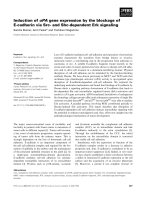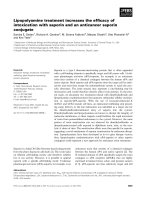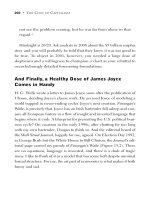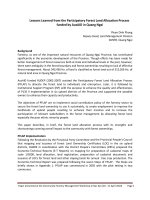The Financial Management Toolkit The Missing Financial Management Planning Process Theory and Tools Guide ITIL Compliant_4 doc
Bạn đang xem bản rút gọn của tài liệu. Xem và tải ngay bản đầy đủ của tài liệu tại đây (193.29 KB, 13 trang )
Financial Management Workbook
Page 39
Financial Management Workbook
Page 40
Fortunately there is a simple procedure available.
For example, an organization seeks to purchase service management
process automation software. The organization has an 8% discount rate. The
useful life of the software is set to 5 years. A prior NPV analysis of the
tangible costs and benefits shows an NPV of -$139,755. If the intangible
benefits are large enough, the NPV could go from negative to positive. To
compute the benefit required (inflow), first we need to know the Present Value
Factor (e.g. 3.993):
NPV excluding intangible benefits, $139,755
= $35,000
Present value factor (8%, 5 years), 3.993
The result serves as a subjective guideline for estimation. If the intangible
benefits are at least $35,000, then the NPV is acceptable. The process
automation should be performed. If in the judgment of senior managers, the
intangible benefits are not worth $35,000, then the process automation should
not be performed.
Financial Management Workbook
Page 41
The NPV of one project cannot be directly compared to another unless the
investments are equal. As a result, the IRR is widely used for preference
decisions. The higher the rate of Internal Rate of Return, the more desirable
the initiative.
The IRR is the rate of return over the life of the initiative. IRR is calculated by
finding the discount rate that equates the present value of a project’s cash
outflow with the present value of its inflows.
The IRR is the discount rate resulting in an NPV of zero.
Financial Management Workbook
Page 42
Many companies successfully justify service management implementations
through qualitative arguments, without a business case or plan, often ranking
cost savings as a low business driver. But without clearly defined financial
objectives, companies cannot measure the added value brought by service
management, this introduces future risk in the form of strong opposition from
business leaders. Having experienced a history of shortfalls in past
frameworks, stakeholders may question the resultant value of a service
management program.
Program objectives can range from simple terminology to the adoption of
industry practices:
• Deliver consistent and repeatable service
• Lower the overall total cost of ownership
• Improve quality of service
• Implement industry-wide best practices
• Provide an overall structure and process
• Facilitate the use of common concepts and terminology.
An Example Model: Calculation of a service management ROI is
available on page 107.
Financial Management Workbook
Page 43
Note: data collection for process transactions will differ from data collection
for a function.
Financial Management Workbook
Page 44
Forecast analysis: a trend line analysis or another forecasting model is used
to project data points had the program not taken place.
An Example Trend Line Analysis is available in a separate document on
page 109.
Impact analysis: when a forecasting approach is not feasible, either due to
lack of data or inconsistencies in measurements, an alternative approach in
the form of estimations is performed. Simply put, customer and stakeholders
estimate the level of improvements. Input is sought from organizational
managers, independent experts and external assessments.
Control group: in this technique, a pilot implementation takes place in a subset
of the enterprise. That subset may be based on geography, delivery centre or
organizational branch. The resultant performance is compared with a similar
but unaffected sunset.
Financial Management Workbook
Page 45
Financial Management Workbook
Page 46
Once costs are calculated, ROI can be calculated using the NPV and IRR
techniques mentioned in the earlier slides.
The final stage is identifying qualitative benefits. Qualitative benefits begin
with these detailed in the business case.
Financial Management Workbook
Page 47
3 SUPPORTING DOCUMENTS
Through the documents, look for text surrounded by << and >> these
are indicators for you to create some specific text.
Watch also for highlighted text which provides further guidance and
instructions.
Financial Management Workbook
Page 48
Financial Management Workbook
Page 49
3.1 Objectives and Goals
IT Services
Detailed Objectives/Goals
Process: Financial Management
Status:
Version: 0.1
Release Date:
Financial Management Workbook
Page 50
Detailed Objectives/Goals for Financial Management
The document is not to be considered an extensive statement as its topics
have to be generic enough to suit any reader for any organization.
However, the reader will certainly be reminded of the key topics that have to
be considered.
The detailed objectives for Financial Management should include the
following salient points:
Objective Notes
To determine the cost of IT Services.
Typically, organizations do not fully understand the
costs associated with individual services. This
hinders an effective decision making process
based on reliable information.
Met/Exceeded/Shortfall
☺
Dates/names/role titles
To identify and classify the cost structure.
There needs to be a well thought out cost structure
incorporating a cost model to be able to truly
understand the TCO of the service.
To fairly allocate costs of IT services to both
Internal and External customers.
Typically, organizations that have charging in place
will opt for the easiest way to allocate charges such
as “If we have four customers we allocate a quarter
to each!” This inevitably causes customers who do
not use the full quarter of the service but are
charged for it to look elsewhere for a service
provider.
To introduce charging methods for the use of IT
services, where appropriate.
Moving from a typical cost centre to perhaps a
profit centre may not be for every organization;
however the charging process can show the
customer the value that is being provided.
To operate the IT department as a business unit
where required.
In essence, all internal organizations should be
responsible for their individual longevity; this shift in
Financial Management Workbook
Page 51
thinking makes the IT department fully responsible
for its own future.
To recover all costs including capital costs from the
customer.
The burden of cost should not be borne by the IT
provider. If there is a legitimate business need for a
service, then that cost must be passed to the
customer.
To check charges at regular intervals to determine
if they are realistic and acceptable.
The customer should not be disadvantaged,
ongoing monitoring is necessary to identify market
changes to be in a position to pass savings to the
customer as well as charges.
To shape the behavior of customers and users by
building cost awareness and tying cost directly to
services.
Ultimately the customer is in control. If the
customer is aware of the impact of the cost of
extensive usage of a service, the customer is better
positioned to apply constraints based on business
rules to only use the resources necessary to
sustain the business.
Use these objectives to generate discussion about others that may be more
appropriate to list than those provided.
Refer also to the Communication Plan for ideas on how to communicate the
benefits of Financial Management.









